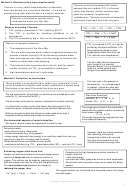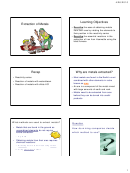Metal Extraction
ADVERTISEMENT
7. METAL EXTRACTION
Converting sulphides to oxides
The occurrence of metals in the Earth's crust
Sulphides ores are usually converted to oxides before
•Rocks that contain a high enough percentage of a
extraction by roasting with oxygen.
metal to be extracted commercially are known as
The most important ore of zinc is mostly zinc sulphide
ores .
2 ZnS + 3O
2ZnO + 2SO
•Aluminium and iron are the most abundant metals
2
2
or copper can be extracted from copper(I) sulphide
in the Earth's crust.
Cu
S + 2O
2CuO + SO
2
2
2
•Most compounds are found as oxides or
The oxide is then reduced with a suitable reducing agent
sulphides, but sulphides are usually converted to
such as carbon.
oxides before extraction.
Sulphur dioxide is an acidic gas that can form acid rain if
released into the atmosphere.
The sulphur dioxide can be used, however, to form
sulphuric acid by the contact process
Which method is used depends on:
Methods of extraction
•the energy requirements
The extraction of metals involves reduction, usually
extraction uses large amounts of energy (electricity and /
of metal oxides.
or heat)
This reduction of the metal compound is usually done
in one of the following ways:
•the cost of the reductant
•by heating with carbon (in the form of coke)
Carbon , which is cheap, is widely used, but sometimes
•by heating with hydrogen
more reactive metals are required which are very costly
•by heating with a more reactive metal (active metal)
•the metal purity required
•by electrolysis
the higher the required purity, the greater the cost in
obtaining that purity
Method 1: Reduction of metal oxides with carbon
In theory all metals can be extracted this way, but for
Carbon and carbon monoxide are cheap, effective and readily
some
available reducing agents
•the temperature required is excessively high
•metal carbides are formed rather than the metal itself
Iron, manganese and copper are extracted using C and CO
(e.g. tungsten, titanium)
o
Fe
O
+ 3 CO
2 Fe
+ 3 CO
Occurs at about 1200
C
2
3(s)
(g)
(l)
2(g)
excess C is easily removed in the
Fe
O
+ 3 C
2 Fe
+ 3 CO
Occurs at higher temps
steel making process
2
3(s)
(s)
(l)
(g)
MnO
+ C
Mn + CO
2
2
The CuO comes from the thermal decomposition of malachite
2 CuO + C
2 Cu + CO
→ CuO + CO
2
CuCO
3
2
Pollution problems arise from using carbon, giving CO
(a greenhouse gas) and CO (toxic)
2
Tungsten cannot be extracted with carbon because
Method 2: reduction by hydrogen (e.g. W)
tungsten carbide (WC) is formed rather than tungsten.
→ W + 3 H
WO
+ 3 H
O
Tungsten (VI) oxide (WO
) is heated with hydrogen at 900°C.
3
2
2
3
Hydrogen is a reducing agent in this reaction
There are risks of explosions and problems
with storage with using hydrogen that must
Advantages of using hydrogen
be carefully managed
no pollution (from CO, CO
)
2
readily available from H
O or CH
2
4
Will give higher purity than using Carbon
Most methods (except electrolysis) are variations of displacement reactions, where a reducing agent is added
to the metal ore. You should be able to construct equations for unusual combinations of ores and reducing
agents e.g. 2V
O
+ 5Si
4V + 5SiO
AlCl
+ 3Na
3NaCl + Al
2
5
2
3
N Goalby
1
ADVERTISEMENT
0 votes
Related Articles
Related forms
Related Categories
Parent category: Education
 1
1 2
2








